The ruins of Mosul have exposed the future of high-tech warfare
Lieutenant Ahmed Abbas Ali burns his finger as he lights the fuse on his chunk of C-4 plastic explosive. A momentary flash of pain pushes aside all thoughts of the car bomb. He's bent over a battered white Chevrolet saloon containing several canisters of explosives wired to an incredibly sensitive pressure trigger. Ali had defused […]Lieutenant Ahmed Abbas Ali burns his finger as he lights the fuse on his chunk of C-4 plastic explosive. A momentary flash of pain pushes aside all thoughts of the car bomb. He's bent over a battered white Chevrolet saloon containing several canisters of explosives wired to an incredibly sensitive pressure trigger. Ali had defused two nearby improvised explosive devices (IEDs) in the past half hour, cutting the wires of bombs half buried by the roadside. This one, though, is too dangerous to tamper with. It is one of Daesh's newest and most dangerous IEDs, the same design that had killed several of his comrades over the past few months. So he decides to blow it up.
The car is parked on a quiet street in west Mosul's Islah al-Zarai, a middle-class district of two- and three-storey houses sprawled behind concrete walls. Iraqi forces had retaken it from Daesh a fortnight previously there was still fighting nearby. Some local residents had already returned to their homes. Others never left.
The dozen or so soldiers acting as an escort to Ali's four-strong explosive ordinance disposal (EOD) unit hammer on metal gates along the street, shouting orders to clear the block as men, women and children emerge squinting into the fierce June sunshine. An officer radioes in the co-ordinates to a command post and, in brisk Arabic, requests permission to detonate.





